Samsung Galaxy S 4 Review - Part 1
by Brian Klug on April 24, 2013 12:01 AM ESTBattery Life and Charge Time
The Galaxy S 4 features a removable 9.88Wh battery with 3.8V chemistry. The battery design is par for the course for any high end smartphone, but the fact that it's removable remains a staple of the Galaxy S design. Whether or not the bulk of consumers actually use the flexiblity offered by a removable battery is up for debate, but there's no doubt about the fact that Samsung has a strong following of users who appreciate the feature.
Unfortunately, only having access to the Sprint version of the Galaxy S 4 to review, most of our battery life tests on the cellular network aren't all that useful. The good news is that our WiFi tests should at least give you an idea of how well the SGS4 will compare to the HTC One when both are on the same network. We're using the latest revision of our smartphone battery life test to compare performance of all the key players here. This is now our sixth revision of the battery life test, and we feel is the optimal balance between challenging workloads and idle time. The basic overview is the same as the previous test — we load webpages at a fixed interval until the handset dies, with display set at exactly 200 nits as always. Power saving features are disabled if they turn on automatically, and background account sync is disabled. The test is performed over both cellular data on all available air interfaces and over WiFi in an environment with good signal levels. The new test has decreased pause time between web page loads and added a number of JavaScript-heavy pages. I sat down with some UMTS RRC (Radio Resource Control) emulator tools and also made sure we had a good balance of all the RRC states (DCH, PCH if possible, FACH, IDLE) so we weren’t heavily biased towards one mode or the other.
As the most relevant comparison of platforms we have today, we'll start with the WiFi version of our web browsing test:
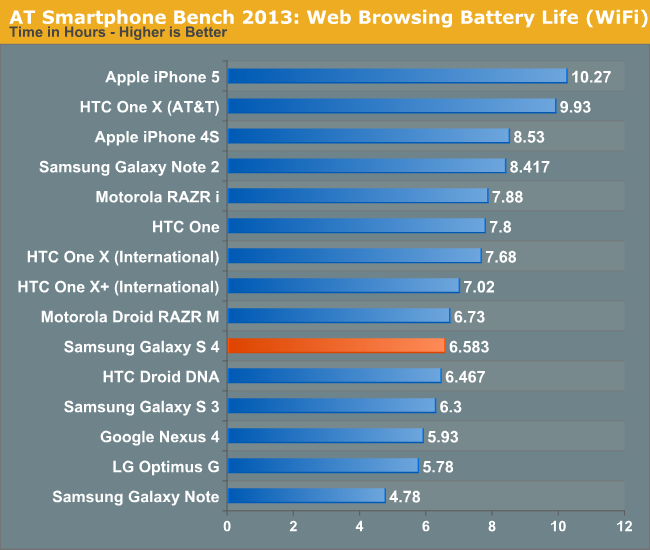
On WiFi the Galaxy S 4 falls behind the HTC One by an appreciable amount, however there's still an improvement in battery life compared to the Galaxy S 3. The Galaxy S 4's battery life isn't bad by any means, but do keep in mind that this is a large phone with a large display and a very powerful SoC. For much of the past year we've been talking about an increase in dynamic range in total platform power of high end smartphones and the Galaxy S 4 is no exception. Run it at full brightness or keep many cores running in their maximum performance states for a considerable period of time and you'll be greeted by a phone that's quickly in need of a power outlet.
As I mentioned earlier, we only have access to the Sprint version of the Galaxy S 4 at this point which unfortunately means that our 3G results aren't all that comparable to other devices here.

Even on Sprint, the Galaxy S 4 does surprisingly well.
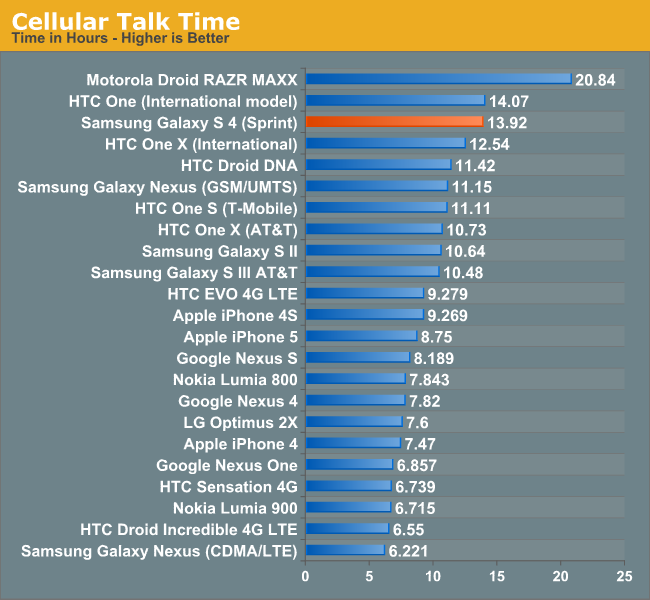
Talk time is excellent on the Galaxy S 4, with the phone delivering effectively the same battery life as the HTC One. Without having to power on that huge display, the Galaxy S 4 can last for a very long time on a single charge.
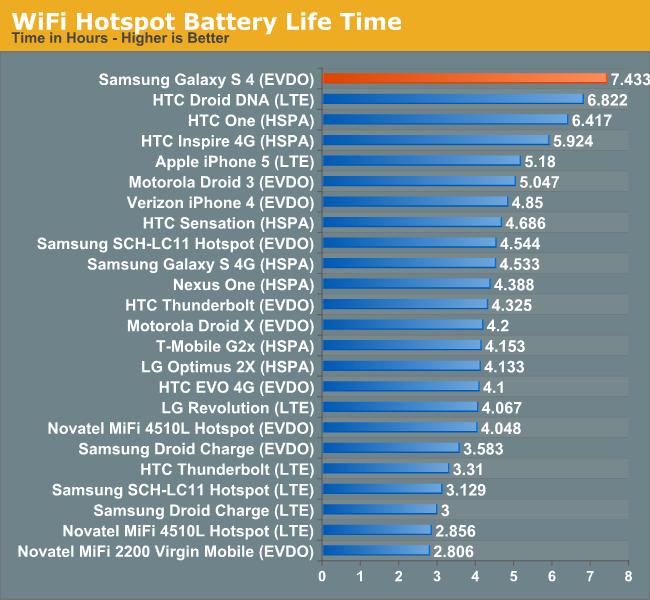
A combination of the Sprint network and the fact that the Galaxy S 4's display remains off during our hotspot test resulted in great battery life here as well. Again, this data isn't all that useful if you're not on Sprint but Samsung tells us we should be able to get our hands on an AT&T SGS4 in the not too distant future.
Charge Time
Samsung appears to implement Qualcomm's Quick Charge specification in the Galaxy S 4 and its bundled charger. I realize we haven't done a deep dive into what Quick Charge is and how it works, but I'll try to go through a quick explanation here. Most conventional chargers are linear, they take a fixed amount of input current (at 5V) and pass it along to the device being charged. The problem is that at deeply discharged states, the device's battery might be at a substantially lower voltage. A traditional linear charger won't change the current supplied based on the voltage of the battery being charged, and as a result can deliver sub-optimal charge times. When implemented, Qualcomm's Quick Charge technology can vary output current based on the voltage of the battery being charged, which results in less power being dissipated as heat and more being delivered to charging the battery itself. The table below helps illustrate the savings:
Quick Charge, at least in its currently available 1.0 specification, is still bound by the 5V limits of the USB BC 1.2 specification. The next revision of Quick Charge will enable higher voltage operation for even faster charge times.
| Qualcomm Quick Charge 1.0, Theoretical Example | ||||||
| Input Current @ Voltage | Input Power | Output Current @ Discharged Battery Voltage | Output Power | |||
| USB BC 1.2 - Linear Charger | 475mA @ 5V | 2.375W | 475mA @ 3V | 1.425W | ||
| Qualcomm Quick Charge 1.0 | 475mA @ 5V | 2.375W | 700mA @ 3V | 2.100W | ||
The non-linear nature of Quick Charge significantly shortens charge time, particularly in the very early stages of charging when the device's battery is presumably fully discharged. As the device's battery voltage increases, current delivery tapers off and the QC advantage is no longer as great as a standard USB BC 1.2 solution. The end result though is significantly improved charge times.
The graph below shows the benefits of using Samsung's own charger vs. a standard charger that implements the USB BC 1.2 specification. When used with the bundled charger, the Galaxy S 4 recharges much faster than HTC's One, despite using a larger battery. Obviously the Galaxy S 4 will charge with any USB charger, but the charge time will simply be longer. Samsung uses a voltage divider and signals the presence of their own charger by sending 1.2-1.3 V across the D+ / D- pins, this is similar to what Apple does with 2.0 or 2.8 V across the pins for various USB chargers they've shipped over the years. This signaling is essentially Samsung's proprietary tablet charging signaling which they've employed on the Galaxy Note 2 and now SGS4, in fact the two use the same exact charger, so it's worth tossing out your old ones and getting the appropriate one to take advantage of the faster charging.
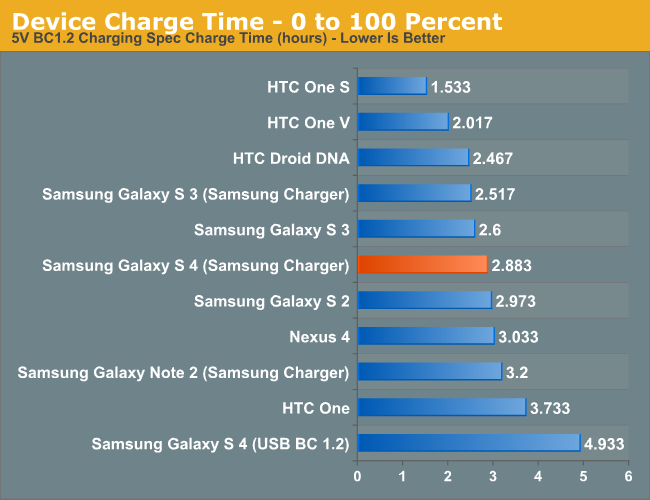


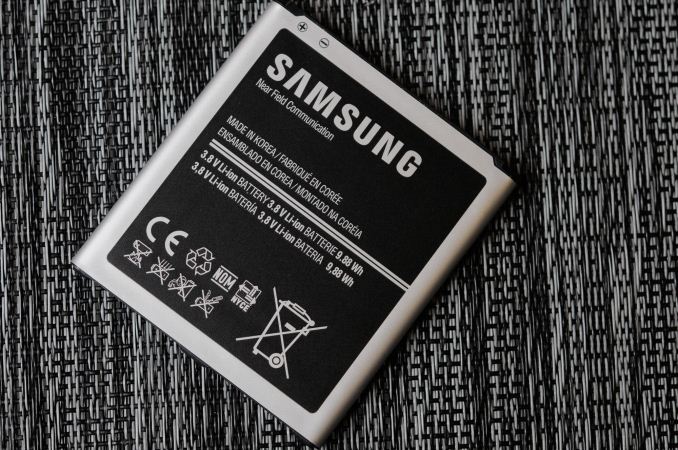








335 Comments
View All Comments
Exodite - Wednesday, April 24, 2013 - link
The screen I'd imagine.The iPhone 5 has a screen that's ~65% the size, and ~35% of the resolution, of the one used by the Galaxy S4.
Its not the only reason of course but the screen matters a lot.
gnx - Wednesday, April 24, 2013 - link
Also a weakness of AMOLED. Since it needs to lighten up all subpixels max to get to white (and turns off all subpixels for gorgeous black). So web browsing, with so most sites having white background, really cranks up the power consumption of the display, hence the unexpectedly shorter battery life compared to other scenarios.sigmatau - Thursday, April 25, 2013 - link
I have a Nokia 900 with a Samsung sourced AMOLED plus which is beyond terrible outside on full brightness. I wonder how this one compares.lopri - Wednesday, April 24, 2013 - link
In that chart, iPhone 4S is leading Nexus 4. I have both and I call that bogus. Not sure what kind of iPhone 4S they've got.kmmatney - Wednesday, April 24, 2013 - link
We have mostly iPhones at my work, but a few SG3s. It's pretty easy to compare the real-use battery life at a conference, where we have to be on battery all day, and use are phones for normal stuff like email, texts, some web browsing, etc.. Without fail, the iPhones are all still going strong at the end of the day, while the SG3s have dead batteries. I was hoping the SGS4 would fix this, but I can't tell from the review. I hope the Note 3 increases the battery life.RealityMonster - Monday, April 29, 2013 - link
Apple has consistently refused to put tech in their phones unless they can still get 10hrs of battery life out of it. That's why the iPhone 5 is the first one to have LTE--the 4s just couldn't keep a charge long enough. Part of it is the form-factor, since a smaller phone means a smaller battery. Like other people have mentioned, though, the smaller screen is also a smaller power draw.So while you're never likely to see an iPhone that has a substantially better battery life than 10hrs under browsing conditions, you'll never see one that has a substantially lower life, either.
Gorgenapper - Tuesday, May 14, 2013 - link
That's a nice thing about Apple, they have a MUCH tighter control on their design and execution than Samsung ever could. People love to bash on Apple, and I admit that I'm not a big fan of many of Apple's decisions and products, but at least they know what they want to do, and go after it.Samsung, on the other hand, is more concerned with features, and less concerned with the quality of the execution of their overall product plan. I also get a vibe that Samsung caters more directly to the 'buy and throw away' mentality of most consumers, as OLEDs degrade at a faster rate than LCD (particularly blue subpixels), which was a reason why Samsung said that they used a pentile arrangement on the S3.
As for me, personally, I think I'll wait to see how the next gen iPhone looks like (rumored 4.5 ~ 4.8" screen), or more likely I'll wait to see how the next gen Nexus is. Assuming that I can't score a cheap 32gb Galaxy S4 after the big hype dies down.
mike55 - Wednesday, April 24, 2013 - link
I'm definitely torn between this and the HTC One. I'm also a bit disappointed that 32 GB of NAND isn't the standard minimum for flagship smartphones these days.Toss3 - Wednesday, April 24, 2013 - link
Both are great phones, but I'm buying the S4 because of the larger screen and smaller bezel. I also cannot stand the button layout of the HTC One. Was very surprised to see that the HTC One was very fluid, whereas the S4 stutters a bit. Especially considering the latter runs the SoC at a higher clockspeed. I also believe the camera of the S4 to be superior; even if the HTC One takes better night-shots, they're still not good enough for print or even watching on a 1080p TV(lots of noise and weird white-balance). The daylight shots from the S4 look pretty good, and are among the best of any phone right now.UpSpin - Wednesday, April 24, 2013 - link
4MP (2688x1520) translates to 22,76x12,87cm (8,96x5,067in) @ 300 DPI print resolution, I think that's enough. It's also above 1080p. People also forget that the HTC One contains a simple OIS!http://www.htc.com/www/zoe/stabilization/
But you're right, at best lightnig conditions, the S4 is superior, but I mostly never take pictures at best lightning conditions, but outside on a normal day, indoors poorly lit or indoors to scan documents.
According to other reviews the S4 stutters because of the gimmick features, once you turn off those advertised stuff, it should run better.